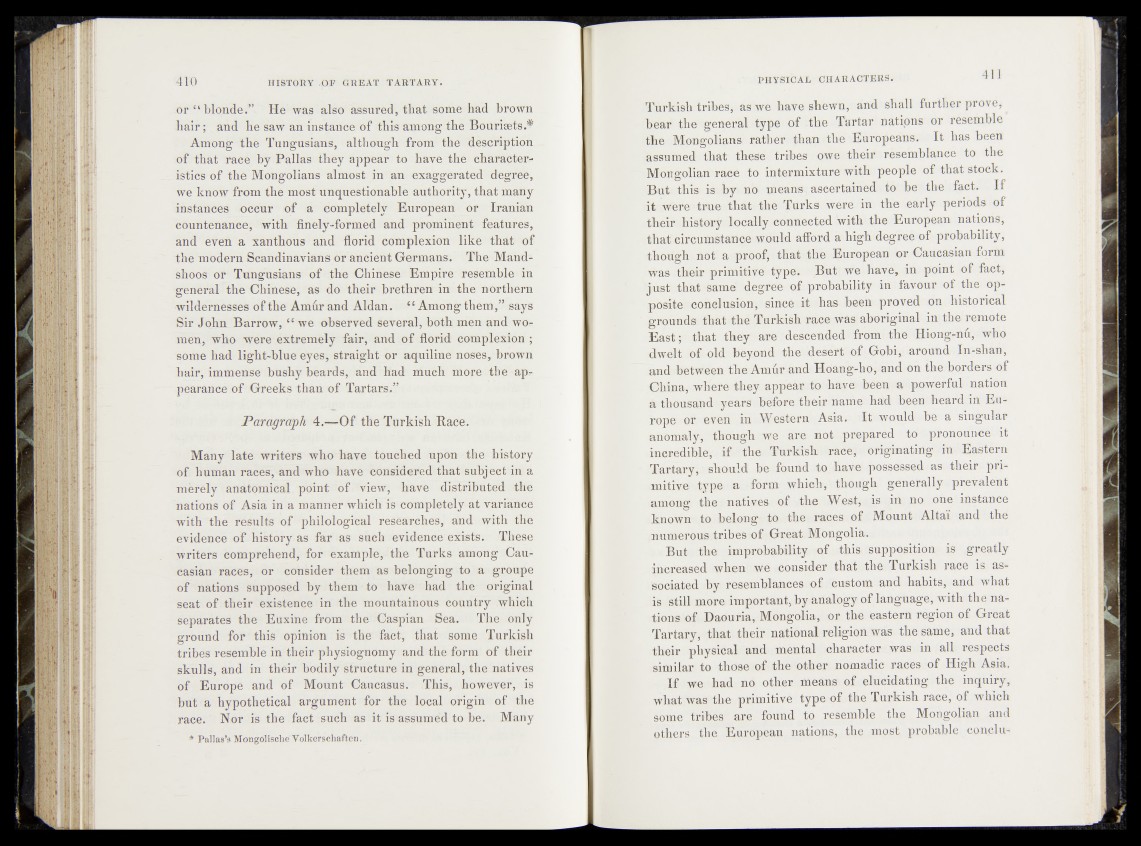
or “ blonde.'” He was also assured, that éome had brown
hair ; . and he saw an instance of this among thé Bourisets.^
Among the Tungusians, although from the description
of that race by Pallas they appear , to have the characteristics
of the Mongolians almost, in an exaggerated degree,
we know from the most unquestionable authority, that many
instances occur of a completely European or Iranian
countenance’ with finely-formed and prominent features,
and even a xanthous and florid complexion like that of
the modern Scandinavians or ancient Germans. The Mahtt-
shoos or Tungusians of the Chinese Empire resemble in
general the Chinese, as do their brethren in the northern
wildernesses of the Amfir and Aldan. “ Among them/’ says
Sir John Barrow, “ we observed several, both men and wo?
men, who were extremely fair, and of florid completion ;
some had light-blue eyes, straight or aquiline^ noses, 1 brown
hair, immense bushy beards, and had much more -the:' apr
pearance of Greeks than of Tartars/’
Paragraph 4.—Of the Turkish Race.
Many late writers who have touched upon the history
of human races, and who have considered that subject in a
merely anatomical point'of view, have distributed th'i
nations of Asia in a manner which is completely at variance
with the results of philological researches, and with the
evidence of history as far as such evidence1 exists*? These,
writers comprehend, for example, the Turks amongSCau-
casian races, or consider them as belonging to a groupe
of nations supposed by them to havé had the original
seat of their existence in the mountainous country which
separates the Euxine from the Caspian Sea. The Only
ground for this opinion is the fact, that some Turkish
tribes resemble in their physiognomy and the form of their
skulls, and in their bodily structure in general, the natives
of Europe and of Mount Caucasus. This, however, is
but ca hypothetical argument for the local origin of the
race. Nor is the ifact isuch as it is assumed to be. Many
* Pallas’sMongolische Völkerschaften.
Turkish tribes*. as we have shewn, and shall further prove, ^
bear the general type of -the Tartar natipns or resemble
the Mongolians rather than the Europeans. It has been
assumed that these tribes owe their resemblance to the
Mongolian race to intermixture with people of that stock.
But thisrds by no means,, ascertained^ to be the fact. If
•it were true that thé* Turks were in the early periods of
their'.Jristory locally connected with the European nations,
that circumstance would afford a-Aigh degree of probability,
though not a proof, that the European or Caucasian form
was their primitive type. But? we have, in point of fact*
Ijmsf'thaGsame degree of probability in favour of the opposite
concl usionj^sinceyif«has been proved on historical
grounds that the Turkish race was aboriginal in the remote
East ; that they are descended^from the Iliong-nû, who
dwelt of old beyond the deserfof Gobi,.4 around In-shan,
iand between the Amur and Hoang-ho, and. on the borders of
China, wluire they appear to have^ been a powerful nation
a thousanckyears before their natrrefhad been heard in Euro
p ee r even in Western Asia. If.would be a singular
anomaly,^, thoughwe, 1 are not prepared to pronounce it
incredible, if $Ce Turkish- ^racek originating in Eastern
Tartary, should be found to have .possessed as their primitive
.type a form whifeh, thougb generally prevalent
among the natives of the West, is 4in no .one instance
known1? to belong- to the races of Mount Altaï and the
.numerous.tribes-of Great Mongolia.
| - Bu&vthe improbability. <of this supposition , is greatly
increased when we consider that the Turkish race is associated
by resemblances of custom and habits, and what
is still more important, by analogy of language, with the nations
of Daouria, Mongolia, \or- the eastern region of Great
Tartary, that their national religions was the same, and that
their physical and mental character was dn all respects
similar to those o f the other nomadic races . of High Asia.
If we had nö other means of elucidating the inquiry,
what was the primitive type *of the Turkish race, of which
some tribes are found to resemble the Mongolian and
others tlie European nations, the,most probablejconpluH